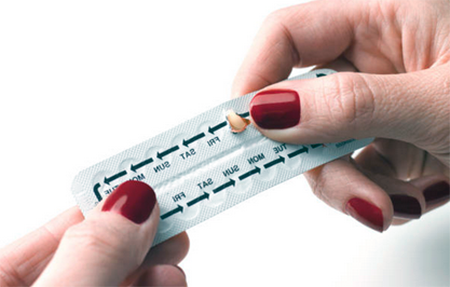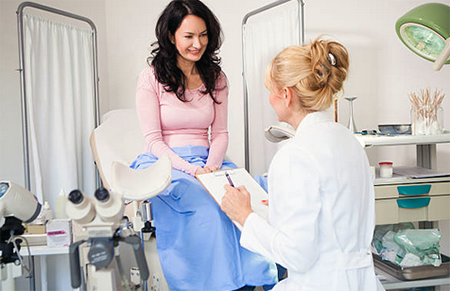Irregular menstrual cycle, menstrual disorders – causes, diagnosis, treatment


The most frequent cause women see a gynecologist is menstrual disorders. This includes irregular period, lack of period, painful period, abundant or scanty period, and so on.
If a woman doesn’t have menstruation for more than 6 months, this disorder is called amenorrhea. If a woman suffers from painful periods, it is dysmenorrhea.
- Amenorrhea accounts for 10-15% of cases of menstrual disorders.
- Around 90% of complaints about the menstrual cycle are related to dysmenorrhea.
- 10% of women with dysmenorrhea lose the ability to work during menstruation.
Key points about menstrual disorders
Now let’s see what is normal menstruation, when to see a doctor, and how to treat different menstrual disorders.
What is a normal menstrual cycle?
The duration of normal menstruation must not exceed 7 days. The normal blood loss during menstruation is 150 mg (not more than 4 pads or tampons a day). The average menstrual cycle length is 28 days but it can be from 21 to 35 days to be considered within the normal range.
When the character and rhythm of menstruations change, it is considered a menstrual disorder but sometimes these changes are normal. For instance, teenage girls commonly have irregular and painful periods because they go through puberty.
The first three years after the onset of menstruation, the cycles last more than 28-35 days, but with age they become shorter, more regular, and are often accompanied by full maturation of the egg.
The normal menstrual fluctuations in teenage girls are:
- First year after the first menstruation – 21-90 days;
- Fourth year – 21-50 days;
- Seventh year – 27-38 days.
Individual menstrual cycle establishes around the age of 19-20 years.
Menstrual cycle of a woman can change during different periods of life:
- First years after the first menstruation, the cycle can be irregular;
- Around the age of 35, the duration of menstrual bleeding can shorten;
- After giving birth, menstruations can be lacking while a woman breastfeeds;
- Around the age of 45-50, a woman is approaching menopause, menstrual cycle shortens, less stable, menstruation can come not every month, bleeding can be more intense or scanty.
All of these changes are absolutely normal and you should not worry about them. But to timely detect any negative changes in your menstrual cycle that can indicate a dysfunction, keep a calendar with the following information:

1. How long is your menstrual cycle? Mark the first day of each period on your calendar. The period between the first days of two menstruations in a row is called a cycle. So you can track the duration and stability of your menstrual cycle, which normally lasts 21-35 days.
2. How heavy your periods are? You can objectively observe your period flow changes if you wring down how heavy your flow is every month. It is worth making notes on the calendar on how much discharge you have each month, how many tampons or pads you use, whether there are any changes in the color and structure of the discharge.
3. Note any changes in vaginal discharge. Write down about any blood staining between periods, changes in vaginal discharge color, their volume, structure and odor, itching, problems with lubrication.
4. Note lower belly aches of any cause (not only period cramps).
5. Note periods of depression, mood swings, irritability, tearfulness, etc.
All of these notes will allow you to paint a detailed picture of your women's health and make it easier for doctors to diagnose your condition and prescribe the right drugs if necessary.
Now let's take a closer look at possible menstrual irregularities.
Menstrual disorders at different age

Violation of menstruation in women after reaching 40 years is most often associated with age-related changes in the reproductive system. At this age, the depletion of the ovarian follicular reserve occurs, and the frequency of anovulatory cycles increases. Such changes in the female body initially cause irregular periods, dysfunctional uterine bleeding, and then menopause.
In young girls, menstruation disorders are often associated with uneven maturation of the hypothalamic-pituitary and ovarian systems. Less commonly, congenital or acquired syndromes, chromosomal disorders, or reproductive system abnormalities can be the cause. Regardless of the cause, the treatment of menstruation disorders should be carried out under the guidance of a gynecologist.
Causes of menstrual disorders
You can conditionally divide the causes of menstrual irregularities into three groups:
- External (physiological) - in this case, there is no direct physiological effect on the process, but there are indirect factors such as: stress, changes in the nature of nutrition, climate change, etc. Consequently, the elimination of the external cause leads to the normalization of the cycle.
- Pathological (pathology of the ovaries, adrenal glands, thyroid, abortion, surgery, etc.) - this includes a huge group of diseases and conditions, which will result in a violation of the regularity of the cycle.
- Medication - when starting the use or canceling certain drugs.
Most common menstrual disorders

- Amenorrhea. Lack of menstruation before puberty, menopause, pregnancy and breastfeeding is due to natural causes (physiological amenorrhea).
In pathological amenorrhea, menstruation is absent due to illness, and not necessarily a gynecological one.
By origin, amenorrhea is divided into:
- Primary - when menstruation is absent when a girls reaches 16 years of age (underdevelopment of the uterus, congenital diseases, ovarian pathology, thyroid gland dysfunction);
- Secondary - in a woman's life there was at least one menstruation (more often before the onset of amenorrhea, the menstrual cycle was normal).
- Dysmenorrhea. Dysmenorrhea (painful periods) by origin is divided into primary (functional), which develops immediately, with the onset of first menstruation or within 1–1.5 years, and secondary (organic), due to gynecological diseases. With compensated dysmenorrhea, the clinical picture does not change, with decompensated dysmenorrhea, the pain increases every year.
The causes of primary dysmenorrhea include:
- Mechanical factor - clogging of the cervical canal, hymen, and vagina. The entire system that is responsible for the menstrual cycle is functioning correctly, and corresponding changes occur in the genitals every month, but menstrual blood does not flow out. The blood accumulated in the uterus leads to its overstretching, which causes pain;
- Constitutional features – this cause is frequent in thin short girls or in hypoplasia (underdevelopment) of the uterus;
- Endocrine factor - a violation of the production and breakdown of prostaglandins, an excess of which causes pain;
- Neuropsychic factor - a low threshold of pain sensitivity or a labile (unstable) psyche.
Secondary dysmenorrhea is caused by:
- Endometriosis;
- Uterine myoma;
- Chronic inflammatory processes of the uterus and appendages;
- Wearing an intrauterine device;
- Adhesive disease and other pathology.
Lack of menstruation may be due to:

- Stress and mental illness;
- Restrictive diet (fasting);
- Engaging in professional sports;
- Chronic intoxication;
- Taking hormonal drugs that suppress the production of female sex hormones and antihypertensive drugs;
- Pathology of the thyroid gland;
- Intrauterine adhesions;
- Tumors of the brain or ovaries.
You need to see a doctor if:

- The first menstruation in a teenager did not appear until the age of 15 or the breast did not begin to develop at the age of 13,
- You don’t have menstruation for more than 90 days;
- Your menstrual cycle becomes irregular after it was established (longer or shorter intervals between periods, longer or shorter period bleedings, heavy or scanty period bleedings);
- The interval between periods is less than 21 or more than 40 days;
- Your period bleeding lasts for more than 7 days;
- Suddenly your period became so heavy that you need to change pads or tampons more often than every 2 hours;
- There is bleeding or brown spotting between periods;
- Suddenly, your periods became painful;
- You suffer from severe period cramps that cannot be relieved with analgesics;
- Sudden fever and painfulness when using tampons.
In heavy bleeding and/or fever and painfulness when using tampons, see a gynecologist right away as these are the signs of dangerous conditions that require prompt help, sometimes even emergency care.
Diagnostics and treatment
Diagnosis for menstrual irregularities includes:

- Ultrasound of the pelvic organs;
- Ultrasound of the thyroid and adrenal glands (if necessary);
- Screening for sexually transmitted infections;
- Blood tests for the hormonal profile (the content of FSH, LH, prolactin, estrogens, and androgens);
- Blood tests for thyroid hormones;
- X-ray of the skull (detection of pituitary pathology);
- Electroencephalography;
- Hysteroscopy and diagnostic curettage of the uterine cavity (strictly according to indications).
Treatment of menstrual disorders
The results of the research will help the doctor get a complete picture, determine the cause, and, if necessary, choose a drug therapy.
Treatment directly depends on the cause, concomitant symptoms, and characteristics of the patient's body. If lifestyle reasons are the cause, it is enough to normalize the daily regimen and rest, improve nutrition, and avoid excessive physical and psychological stress.
When the cycle is disrupted due to infections, inflammatory processes of the ovaries, antibacterial drugs, uroseptics, hormonal drugs, physiotherapy, and vitamins are prescribed. Herbal medicine can be prescribed as an additional aid. The choice of any drug should always be made by the gynecologist, who will select the required dose and duration of administration.

Oral contraceptives and progestogens (such as Duphaston) are considered to be most effective in treating irregular, painful, or heavy periods. However, they should be selected individually for each patient, based on a thorough examination, analysis of hormone levels, and concomitant diseases.
To regulate menstruation, doctors often advise to follow a diet, to exclude contact with any provoking factors. If menstruation disorder occurs due to damage to the cervix, a woman may need surgical treatment. In case of hormonal disorders due to thyroid or adrenal gland dysfunctions, hormone therapy or surgery are appointed.
In the treatment of menstrual disorders in adolescents, special care should be taken. You should not postpone the visit to the gynecologist. An increase in the synthesis of the hormone prolactin by the pituitary gland is a frequent mechanism of menstruation in adolescents. As a result, the production of other hormones that regulate the menstrual cycle is reduced, which can lead to disorders that can result in infertility in the future, for example, due to polycystic ovary syndrome.
Treatment for menstrual irregularities in teenage girls depends on the underlying cause. If a girl trains for professional sports, does not get enough sleep, preparing for classes and exams, it is important to revise the schedule to ensure that a child has a good rest.
Many girls try dieting, which can also affect their period regularity. Such teens need the help of a child psychologist, psychotherapist, with the involvement of a nutritionist.
Ovarian tumors during adolescence are not always benign, so identifying and removing them timely can not only solve menstrual problems but also save a life.
Treatment of diabetes mellitus, hypothyroidism, adrenal hyperplasia, prolactinoma with a number of medications significantly improves the regularity of the cycles.
Menstrual disorders prevention tips
In order to avoid menstrual irregularities, gynecologists recommend women and girls to monitor their health, keep a period calendar, and in no case self-medicate. Every woman must follow certain rules, as well as have the necessary information:

- Girls' periods should begin at the age of 10-14;
- Keep a menstrual calendar;
- Visit a gynecologist at least once every 6 months;
- Timely treat all gynecological diseases;
- Do not to self-medicate, uncontrolled intake of medications can severely damage a woman’s health;
- Balance the menu, avoid highly restrictive diets;
- Lead an active and healthy lifestyle.
Observing the above recommendations of doctors, it is possible to exclude the development of many gynecological diseases or to identify them at the initial stages, when the prognosis for recovery is favorable.
Post by Kate Phillips, gynecologist at Mother and Baby Centre, London, UK
(Updated at Apr 14 / 2024)
Duphaston articles:
Some of the trademarks used in this Web Site appear for identification purposes only.
All orders are reviewed by a licensed physician and pharmacist before being dispensed and shipped.
The statements contained herein are not intended to diagnose, treat, cure or prevent disease. The statements are for informational purposes only and is it not meant to replace the services or recommendations of a physician or qualified health care practitioner. If you have questions about the drugs you are taking, check with your doctor, nurse, or pharmacist.